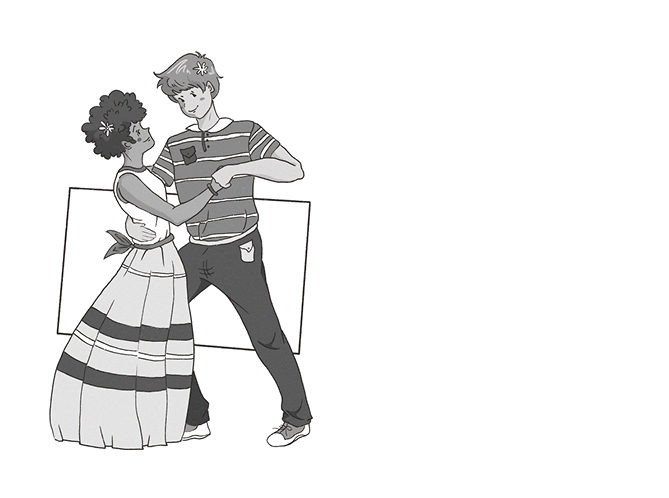
Within the sepia-toned cafeteria of the Connecticut Mental Health Center, Serena Spruill is a vision in dazzling Technicolor. I find her seated in a plastic chair, dressed in a rainbow poncho which only slightly conceals a flashy Obama T-shirt. A fist-sized wooden cross swings from her neck, and a Rastafarian beanie tops her hip-length dreadlocks. In a world beyond the beige rooms of CMHC, Spruill’s size might stand out more than her oufit. She is close to six feet tall and weighs over three hundred pounds.
And she isn’t happy about it.
“I look at myself, and I realize—what you’re seeing here on the outside doesn’t reflect who I am on the inside.” Spruill motions to the rest of the cafeteria. “Everybody around here sits around like blobs,” she says. “But I’m trying to make my life better. I want to improve my health.”
Spruill’s weight struggles started fifteen years ago, when she was diagnosed with paranoid schizophrenia. Her doctor at CMHC started her on an antidepressant and then an antipsychotic. The medication worked—Spruill was happier and stopped hearing voices.
But like most medications of its kind, it had one significant side effect: increase in appetite. In her first year of treatment, Spruill gained almost one hundred pounds. Her cholesterol rose and she contracted hypertension and type II diabetes—not uncommon for patients on antipsychotic medicines. Since then, she’s participated in weight loss studies and joined an African dance troupe. She attends bi-weekly exercise classes, and consults a nutritionist. She shops for groceries at health stores and farmer’s markets. But she still hasn’t seen any significant weight loss.
Spruill resists attributing her obesity to the side effects of her anti-psychotic medication: “If I did what the nutritionist told me to do, I wouldn’t be overweight. But I just eat too many carbs,” she said. “You see, it’s the pills, but it’s also me.”
Because of her weight, Spruill—and sixty percent of seriously mentally ill patients in America—is four times more likely to contract and die of heart disease, and likely to die twenty to twenty-five years earlier than, the average American. In the past ten years, CMHC has provided patients with formal weight loss trials, exercise groups, a fully-equipped gym, healthier cafeteria food options, a weekly farmer’s market during the summer, and, most recently, a primary care clinic providing nutritional information—all without any cost to the patients. But somehow, nothing seems to work, not even for highly motivated patients like Spruill.
**
Before the 1990s, most Americans fell within a normal body mass index (BMI) range of between 18.5 and 24.9, and the mentally ill were a bit thinner than most. Now, over thirty-five percent of Americans adults are obese, and almost sixty percent of the mentally ill are severely obese. What has changed for the mentally ill is in part what has changed for the American population as a whole: now, as never before in human history, foods high in carbs, calories, and fat are cheap and readily available in our country. But the increased accessibility of processed food is not all that has changed for the mentally ill. The miracle of anti-psychotic medicines—beginning in 1950, with the introduction of Lithium—which can relieve the symptoms of mental illness, exacerbated the problem. Their appetite-increasing side effects made gaining weight all too easy. Additionally, since many people with severe mental illness struggle to secure education or employment, they are likely to be very poor and, as a result, have limited food options. Psychiatric hospitals suddenly had a major obesity problem on their hands.
CMHC was one of the first mental health institutions in the United States to try to tackle this problem, through clinical efforts, like weight loss trials, or holistic efforts such as philanthropically-funded farmer’s markets. Their fight against obesity in the mentally ill population began in 2004, when Dr. Cenk Tek, who specializes in schizophrenia, became alarmed about his patients’ weight.
“The first year I was here, two people died of heart disease,” says Tek, “I saw that it is not just a statistic that these patients die early. You are living with them sometimes, you take care of them, you establish a relationship with them… I have some degree of responsibility here.”
In response, he developed a weight loss program called SIMPLE (Simplified Intervention to Modify Physical activity, Lifestyle, and Eating), whose structure was comparable to Weight Watchers but with less complex guidelines. During its four-month clinical trial in 2004, SIMPLE taught a group of CMHC patients about the dangers of emotional eating, the benefits of exercise, and how to shop for healthy, affordable foods at the supermarket. But most importantly, SIMPLE emphasized education and weight-monitoring—efforts that have been proven to help patients lose weight. They were successful within the terms of the study. On average, participants lost five percent of their body weight, and they kept it off for another six months. But when the monitoring stopped, participants started to gain back the weight. Now, five years later, all the participants are back where they started.
Tek stills keeps up this monitoring, however, in a less formal way. “Everyone who comes into my office gets on the scale,” he insisted, despite my protestations, “Even you.”
This forced confrontation of one’s body size— an experience that was painful for me and is painful for many—is supposed to help people lose weight. But none of Tek’s patients seem to be doing so, and with this in mind, I am wary when Tek says that SIMPLE will help CMHC patients once it is finally reviewed and certified. If the general American population is any model, my suspicion is warranted. Only 27% of Americans who participate in Weight Watchers, for example, succeed in maintaining their new weight for two years.
Tek still assures me that SIMPLE can work. He explains that his patients have different motives and goals for weight loss, blaming the failure of programs like Weight Watchers on their business model: they primarily target people trying to get beach bodies. Tek is not running a business, or even trying to make his patients thin. He just wants them to be healthy. “I am dealing with very sick people,” he says.
What really separates SIMPLE from other programs is its idea that people don’t need to be thin, or even a normal weight, to be healthy. They can be somewhat overweight and still prevent hypertension, type II diabetes, and heart disease—if they’re living a healthy lifestyle. People who start walking around the block and buying canned veggies at the grocery store can prevent the onset of many fatal health problems.
It sounds easy—so why is it so hard? Perhaps because I am not the only person who sees more than a number when they get on Tek’s scale.
**
Most health care institutions have invested in Tek’s methods, including the new Wellness Center within CMHC. The Wellness Center is a subsidiary of Cornell Scott Hill-Health Center, Connecticut’s oldest and largest community health center, and it provides free primary health care to all CMHC patients.
The only marker of this recently opened and long-anticipated office is a small printed sign taped to a light wooden door; I almost missed it among the many bulletin boards. For now, it is empty: the Wellness Center only opened a week ago, and most patients don’t yet know it exists. But doctors assure me that once the word does get around, the Wellness Center will play a vital role in helping CMHC patients lose weight. It will monitor the weight of every patient who comes in, a requirement of the federal grant that allows the Wellness Center to exist. Additionally, nurses will educate patients on healthy lifestyle choices and the effects of their obesity-related diseases.
John Brenner, the primary nurse practitioner at CMHC’s new Wellness Center, has worked at other primary health care clinics in the past, and attests to the value of regular weight monitoring and education over the long term. He says that at clinics, he explains the issue of obesity and the complications of hypertension and diabetes to patients some thirty times a day. They are very receptive to this education, he says. “A patient will walk out saying, ‘Wow, I finally get this. Thank you, no one has ever explained that to me before.’ And even if that level of understanding is very low, it’s better than where they were before.”
Brenner reports that at the other Cornell Scott Hill-Health Center clinics, the numbers suggest that weight monitoring and education are effective. “If this population is similar to other populations Cornell Scott Hill-Health Center has been treating, then this center should help people with weight—even if in just a small way,” he told me matter-of-factly.
His claims will be tested in the next few years— if CMHC can build up enough patient volume to keep the Wellness Center alive after the federal grant money runs out. The hospital hopes that if it can attract enough patients, and enroll more of them in Medicaid and Medicare, the Wellness Center will be sustainable. But first they’ll need to get enough patient volume to fill up all the appointment slots.
**

The dirty parking lot of CMHC hardly seems like the ideal location for a Friday farmers’ market. But for the past three years, from July through September, the CMHC parking lot has been filled with white tents selling farmers’ fresh-off-the-vine bulging eggplant, an explosion of kale and lettuce, and the still-wafting smell of this morning’s fresh-baked bread. As it turns out, the parking lot is actually the ideal place for a farmers’ market, for a number of reasons.
The market makes financial sense for the hospital administrators. The cost is minimal—City Seed, a New Haven nonprofit, sets up the farmer’s market in the CMHC parking lot without hospital funds. Additionally, for the Connecticut Mental Health Center Foundation— the nonprofit that provides supplemental, donated funding to CMHC—the farmers’ market is actually a moneymaking venture. Donors love everything about the farmers’ market—it’s environmentally friendly, it’s beautiful, and, as of late, it’s trendy. Since setting up the farmer’s market three years ago, the foundation has actually seen an increase in donations. They attribute this to their strategy of donor outreach, which highlights efforts to promote a “wellness” culture in the hospital—a holistic approach to health that doesn’t focus on weight loss but rather on the individual as a part of a community.
It all sounds very nice, especially when you throw in the live musicians every week and guest-star appearances from a bike repairman, patients selling crafts, and—most memorably—an equine therapist. The farmers’ market’s possible impact on the community is a large selling point to donors also. The idea is not just to change the food culture at CMHC, but in the Hill as a whole.
Normally, it would be hard for patients and the surrounding community to afford to shop at a farmers’ market. But City Seed has introduced a program to accept food stamps for double their stated value at the market, and the CMHC foundation funds the distribution of coupons to CMHC patients, which gets them additional produce for free.
According to patients, this financial inclusivity created a unique social environment. “You get to interact with the higher-ups, the doctors, the administrators,” Spruill said. “You don’t normally get to do that.”
These social interactions are not just selling points for donors, however. They have real clinical benefits.
“Keeping people coming to their appointments is a tremendous problem for us,” says Dr. Michael Sernyak, CMHC’s director. With the arrival of the farmer’s market, patients started keeping their appointments in order to get coupons. Clinicians even began to see better appointment attendance on Friday mornings, compared to the rest of the week.
Doctors and nurses at CMHC all agree that the farmers’ market is the beginning of something good.
“If weight loss is your outcome of interest, a lot of people are going to be very disappointed. Most people won’t succeed,” Sernayk said. “We want to avoid that disappointment. We want to start engineering success to begin with. If we focus instead on walking a little more or eating better, people might start to lose weight.” But that’s a big “might.”
At this point, there have been no success stories among CMHC patients. In fact, the only person to lose significant weight at CMHC has been its director—and Sernyak didn’t lose weight by just walking around the block.
When he came to the hospital three years ago, Sernyak was on the brink of obesity. “I weighed in at 226 pounds. I’m a physician, so I know how this story ends. I don’t want to be in the best shape of my life after I’ve had my first heart attack.” He started counting calories on his iPhone, buying more fruits and vegetables, eating breakfast, and exercising—a lot. He often spent an hour and a half on the Stairmaster every day. In eight months, he lost over sixty pounds. To keep up his new body, Sernyak bikes a few hundred miles a week. He also keeps a treadmill in his office, so he can walk while working.
Sernyak does realize that his method wouldn’t work for many of his patients. “If I’m a single parent with a kid, I can’t disappear for five hours on a bicycle ride. And because I have enough money, I can eat really good food that’s good for me.” Losing weight is just plain hard, even with all his advantages, he says. Despite these caveats, Sernak remains confident that eventually, a patient will overcome the challenges of losing weight.
“There will be one or two people who succeed, and you never know who that’s going to be. The changes for most people may not be dramatic, but small weight changes can make a big difference in peoples’ lives.”
**
For Spruill, healthy eating and exercise are spiritual practices. She wants to be healthy and alive for as long as possible, so that she can fulfill what she sees as her mission to help those around her.
“It’s part of my spiritual involvement to go into somebody’s life, affect them in a positive way, and then move on,” she says, fiddling with the cross on her neck. “It’s like the ripple effect.”
Between Spruill’s strong sense of motivation and the aid of CMHC, she is set up for success, but something is standing between her and what she wants.
“I grew up very poor,” Spruill explains. “We would usually eat one or two meals a day. I didn’t even know what lunch was.” She and her twelve siblings ate healthy things—beans and rice and oatmeal, and even vegetables from the garden before Spruill’s family moved from North Carolina to the Northeast. But they ate lots of it. Enough to be very full, especially since sometimes they would have to go two or three days without food.
“That’s why I can’t stand to be hungry,” she said. “I can’t stand that gnawing feeling still, and that goes way back to when I was a kid, dealing with hunger as a child.”
People’s relationships with their bodies run deeper than what numbers can convey. Even though Spruill has a lot of support and aid—regular visits to a nutritionist, money to buy healthy food, and a moderate exercise regimen—her past remains with her.
For now, the hospital’s obesity problem remains more or less the same as it has been since clozapine came on the market in 1990.
“Things are changing, it’s coming,” Spruill said. But whether or not her optimism will ultimately lead to the numbers going down at CMHC—on the scale in the wellness center, or in the nearby emergency room— remains to be seen.


